Daunt Surname Ancestry ResultsOur indexes 1000-1999 include entries for the spelling 'daunt'. In the period you have requested, we have the following 113 records (displaying 81 to 90): Single Surname Subscription | | | Buying all 113 results of this search individually would cost £558.00. But you can have free access to all 113 records for a year, to view, to save and print, for £100. Save £458.00. More... |
These sample scans are from the original record. You will get scans of the full pages or articles where the surname you searched for has been found. Your web browser may prevent the sample windows from opening; in this case please change your browser settings to allow pop-up windows from this site. Retired officers of the Royal Navy and the Royal Marines
(1898)
The Navy List, published by Authority, corrected to 18 December 1898, has this list of the officers on the Retired List of the Royal Navy and the Royal Marines. Each officer's surname, christian name, and any middle initial(s) is given; with rank, and date of seniority in that rank. The ranks are: A, Admiral; A E, Assistant Engineer; A F, Admiral of the Fleet; A P, Assistant Paymaster; Art E, Artificer Engineer; As Ck, Assistant Clerk; B, Boatswain; Bandr, Bandmaster Royal Marines; C, Captain; Car, Carpenter; Ch, Chaplain; Ch B, Chief Boatswain; Ch Cr, Chief Carpenter; Ch E, Chief Engineer; Ch Gr, Chief Gunner; Ch P; Paymaster-in-Chief; Ck, Clerk; Cr, Commander; D I H, Deputy Inspector-General of Hospitals and Fleets; E, Engineer; E Ins, Inspector of Machinery; F E, Fleet Engineer; F P, Fleet Paymaster; F S, Fleet Surgeon; Gr, Gunner; H Sch, Head Schoolmaster; I H, Inspector-General of Hospitals and Fleets; L, Lieutenant; Mid, Midshipman; N C, Naval Cadet; N I, Naval Instructor; P, Paymaster; R A, Rear Admiral; S, Surgeon; S C, Staff-Captain; S Cr, Staff Commander; S E, Staff Engineer; S L, Sub-Lieutenant; S P, Staff Paymaster; S S, Staff Surgeon; Schm, Schoolmaster Royal Marines; St Ma, Sergeant Major Royal Marines; V A, Vice Admiral; W O, Warrant Officer Royal Marines. DAUNT. Cost: £6.00.  | Sample scan, click to enlarge
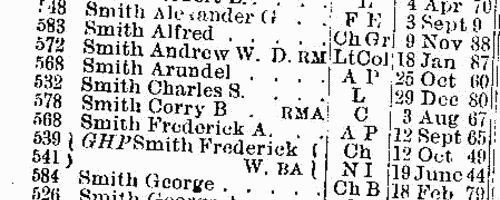
|  British artillerymen fighting in South Africa
(1899-1902) British artillerymen fighting in South Africa
(1899-1902)
The Queen Victoria's South Africa Medal was awarded (after her death, in the event) to all who had served honourably in the various campaigns in the Boer War. Returns were made from each unit, and consolidated into nominal roll, of which this is the one for the Royal Artillery. Confusingly, the ledgers used had originally been printed for a register of men transferred (or re-transferred after mobilization) to 1st Class Army Reserve. All the original column headings were therefore struck through, and the roll was prepared with this information: Date of Issue; Regimental Number; Rank; Name; Unit; Medal (a 1 indicating that a medal was awarded); [number of] Clasps; the reference to the source in the original returns, usually starting with AG for papers in the hands of the Adjutant-General, and 68/Art/ for the Royal Artillery records. The final column, normally left blank, was occasionally used for explanatory remarks.DAUNT. Cost: £8.00.  | Sample scan, click to enlarge

| Missing Next-of-Kin and Heirs-at-Law
(1905)
The Unclaimed Money Registry and Next-of-Kin Advertisement Office of F. H. Dougal & Co., on the Strand in London, published a comprehensive 'Index to Advertisements for Next of Kin, Heirs at Law, Legatees, &c., &c., who have been Advertised for to Claim Money and Property in Great Britain and all Parts of the World; also Annuitants, Shareholders, Intestates, Testators, Missing Friends, Creditors or their Representatives, Claimants, Unclaimed and Reclaimed Dividends and Stock, Citations, Administrations, Rewards for Certificates, Wills, Advertisements, &c., Claims, Unclaimed Balances, Packages, Addresses, Parish Clerks' Notices, Foreign Intestates, &c., &c.' The original list was compiled about 1880, but from materials dating back even into the 18th century: most of the references belong to 1850 to 1880. For each entry only a name is given, sometimes with a placename added in brackets: there may be a reference number, but there is no key by which the original advertisement may be traced. The enquirer of the time had to remit £1 for a 'Full and Authentic Copy of the Original Advertisement, together with name and date of newspaper in which the same appeared'. This appendix to the list was issued in about 1905.DAUNT. Cost: £4.00.  | Sample scan, click to enlarge
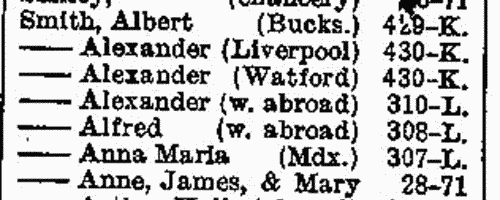
| Members of the Medico-Psychological Association
(1906)
The Journal of Mental Science for 1906 included this list of members of the Medico-Psychological Association of Great Britain and Ireland, giving year of joining, full name (surname first), qualifications, and address: an asterisk indicates a member who joined between 1841 and 1855. DAUNT. Cost: £6.00.  | Sample scan, click to enlarge

| Boys entering Marlborough College
(1908)
The public school at Marlborough in Wiltshire was founded in 1843. In 1952 this, 9th, edition of the college register was published, being a revision by L. Warwick James of the 8th edition (of 1936): but for the years before 1936 it does not merely repeat the 8th edition, because Warwick James was able to correct the 19th-century entries with information from newly-discovered letters and books from 1843 to 1853, and the school lists from 1844 onwards. The roll is arranged by year, and within each year by term of entrance, and then alphabetically by surname within each term. Each boy is assigned a number within the year: then his name is given, surname first, and, in brackets, his house. The houses within the college were called B1, B2, B3, C1, C2 and C3, and the Lower School (L Sch); the out college houses were Preshute, Priory, Cotton, Hermitage, Littlefield, Barton Hill, Summerfield and Upcot. Then there is given the boy's father's name (surname and initials) and address (at entrance), the boy's date of birth (b) and month of leaving (l). Where the boy represented the school at Rugby football (XV) or cricket (XI), in the rifle corps (VIII, or RC XI), that is indicated. There is a brief summary of achievements in later life, and, where known, and date of death or (in italics) address as in 1952. DAUNT. Cost: £4.00.  | Sample scan, click to enlarge
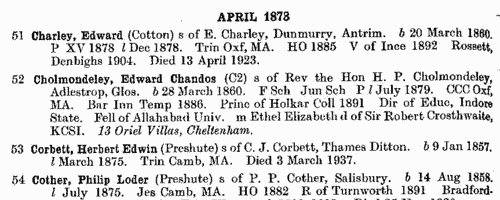
| Boys entering Gresham's School
(1910)
The Sir John Gresham Grammar School at Holt in Norfolk was founded by sir John, who bought the manor house there in 1546 to convert it into a school, and building work had started by 1555. To celebrate the quatercentenary in 1955, a history of the school written by the Reverend C. L. S. Linnell was published, together with an Alumni Greshamienses, a register of boys entering the school from 1562 to 1954, compiled by A. B. Douglas. The materials to hand for the register for the early years were slight; the first coherent lists of boys survive only from 1729, and then are fitful, with little detail, and largely missing from 1784 to 1803; however, from 1810 onwards the names of boys' parents are usually recorded. The register is arranged chronologically by year (and from 1900 by term - L, Lent; M, Michaelmas; S, Summer), and then alphabetically by surname (in capitals) and christian name(s). Where known, year of birth is then given (in brackets), names, addresses and occupations of parents. From 1900 onwards there are italic abbreviations for sporting achievements at school (h, hockey colours; VIII, shooting colours; S, first-class swimmer; XI, cricket colours; XV, football colours), and p for house prefect and P for school prefect; then (in italics) information about the boy's adult life, and his address (where living) at the time of publication. Finally, on the right hand side of the page, in italics, is given the year of his leaving the school. Most detail is absent before 1810; and, of course, for the boys still at school in 1955, or only recently left, there are no details of future career; nor are there the usual details about their parentage. From 1898 onwards day boys are noted with an italic D (N means Newquay dayboy); and from 1900 onwards the school houses are shown (B, Bengal Lodge; F, Farfield; H, School House or Howson's; K, Kenwyn; O, Old School House; W, Woodlands); and, for the junior school, c, Crossways; k, Kenwyn; o, Old School House).DAUNT. Cost: £4.00.  | Sample scan, click to enlarge
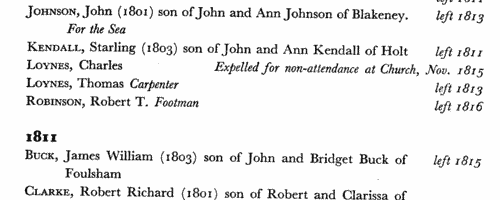
| Civil Servants and Office Holders
(1913)
The Imperial Calendar gives lists of officials and office-holders throughout England, Wales, Scotland and Ireland
DAUNT. Cost: £4.00.  | Sample scan, click to enlarge
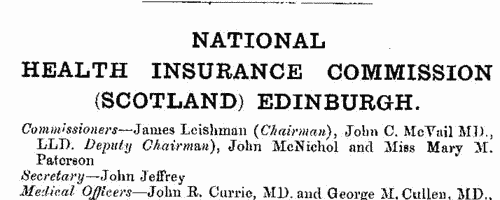
| War Services of British Army Officers
(1915)
Hart's Annual Army List, Special Reserve List and Territorial Force List for 1915 includes this section entitled 'War Services of the Officers of the Active List', covering not only serving officers of the regular army, but also officers of the militia (marked (m)), special reserve (r), territorials (t), volunteers (v) and yeomanry (y). The detailed descriptions of the officers' war services relate not to the Great War, but to previous campaigns, particularly those in South Africa, Egypt, India and China. The regiment &c. in which the officer was currently serving is shown in brackets after his name. DAUNT. Cost: £6.00.  | Sample scan, click to enlarge
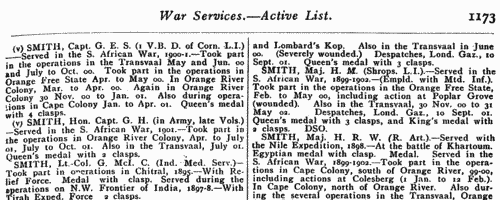
| Boys entering Haileybury College, Hertfordshire
(1918)
Haileybury College, near Hertford, was founded by the East India Company in 1806, and incorporated by Royal Charter in 1864. This register of pupils entering the school from 1862 to 1931 was edited by a master there, Laurence Arthur Speakman. The boys are listed by term of joining the school, and then alphabetically by name (in bold), surname first (in capitals). There is then usually a precise birthdate, and the name and address of his father; his period at the school, starting with abbreviations to indicate the house to which he belonged (B., Batten; B. F., Bartle Frere; C., Colvin; E., Edmonstone; Ha., Hailey; Hi., Highfield; L., Lawrence; Le B., Le Bas; M., Melvill; Th., Thomason; T., Trevelyan), and the first and last forms attended (e. g., IV., fourth form). Where a member of a school team there is then an indication (e. g., XI., cricket). For some pupils, with whom the school had lost touch, Speakman was only able to record the details of their time at Haileybury; but for most a brief career synopsis is then given, and current address (as in 1931) or date of death.
DAUNT. Cost: £4.00.  | Sample scan, click to enlarge
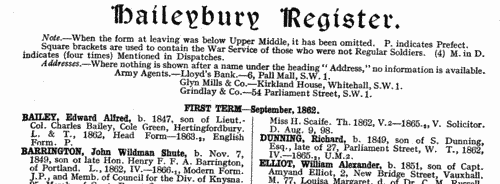
| Boys entering Sherborne School
(1918)
The grammar school at Sherborne in Dorset, which doubtless existed from the creation of the diocese of Sherborne in 705, was refounded by king Edward VI in 1550. At the quatercentenary in 1950, a fourth edition of the Sherborne Register was published, listing boys entering the school during those four centuries. In truth, the materials for this register survive but fitfully before 1823; for some years, no names are known; sometimes all that is known is a surname. But from 1823 onwards the lists and the details get steadily more comprehensive. By the 20th century the boys are listed alphabetically by surname under term of entrance. Surname is given in bold, then christian names, name of father (surname and initials) and address; year of birth; house (a, School House; b, Abbey House; c, The Green; d, Harper House (formerly The Retreat); f, Abbeylands; g, Lyon House; h, Westcott House); whether represented the school at cricket (xi), football (xv), shooting (viii), &c.; year of leaving; summary of degrees, career &c.; and (in italics), address as of 1950. Names in the early lists marked with an asterisk are found inscribed on the oak panelling or on the stone walls of the former schoolroom. (F) in the lists indicates a foundationer, receiving free education: after 1827, when this privilege was restricted to boys from Sherborne and neighbourhood, nearly all foundationers were day-boys.DAUNT. Cost: £4.00.  | Sample scan, click to enlarge
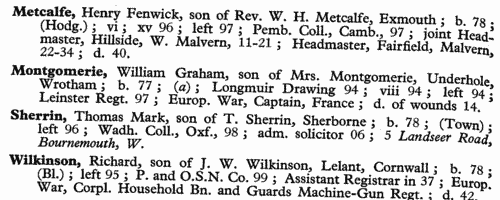
|
Research your ancestry, family history, genealogy and one-name study by direct access to original records and archives indexed by surname.
|













